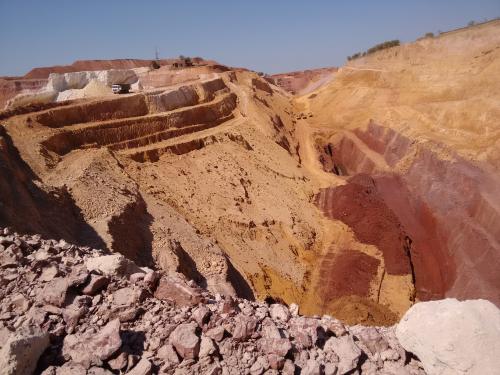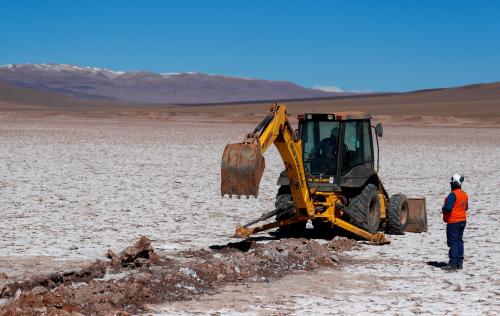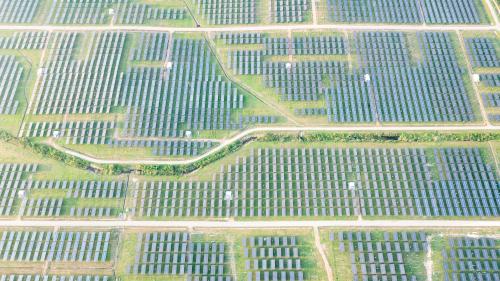Content from the Brookings Institution India Center is now archived. After seven years of an impactful partnership, as of September 11, 2020, Brookings India is now the Centre for Social and Economic Progress, an independent public policy institution based in India.
The Prime Minister of India held a meeting on April 30, 2020 to consider reforms in the mines and coal sector to jump-start the Indian economy in the backdrop of COVID-19. The mining sector, which is a primary supplier of raw materials to the manufacturing and infrastructure sectors, is being considered to play a crucial role for the resurgence of the economy post the lockdown and in the coming years.
While several reforms are being mulled over to boost mining businesses, the Centre and the state Governments also need to consider boosting local livelihoods. In the context of mining districts, the District Mineral Foundation (DMF) funds can be used for prioritising livelihood generation and creating local jobs. The Prime Minister in the latest meeting has also discussed the scope of improving “community development activities” through the fund.[1]
DMF was instituted in March 2015, under the Mines and Minerals (Development and Regulation) Amendment Act 2015. It has been conceptualised as a benefit-sharing mechanism with mining-affected communities, recognising them as partners in natural resource-led development. Set up as a non-profit trust in all mining districts of India, DMF comes with the precise objective to ‘work for the interest and benefit of people and areas affected by mining’, through a participatory process. In September 2015, the Centre further aligned DMF with the Pradhan Mantri Khanij Kshetra Kalyan Yojana (PMKKKY) scheme, to implement various developmental projects and welfare programmes in mining-affected areas using DMF funds.[2]
Livelihood and income generation is a key issue that DMFs need to focus on for mining-affected communities across the country. This has been emphasised through the MMDR Amendment Act 2015 and the respective State DMF Rules developed under it, as well as the PMKKKY scheme. The emphasis comes in three ways.
Firstly, considering the fact that mining-related activities lead to significant displacement and loss of livelihoods in these areas, the law specifically notes that people who have lost their land rights (including user and traditional rights) due to mining or whose livelihood has been affected by such activities, constitute DMF beneficiaries. Secondly, one of the defined objectives of PMKKY is to ensure long-term sustainable livelihood for the people affected by mining. Finally, following the PMKKKY guidelines, livelihood and skill development have been recognised as ‘high-priority’ issues under all state DMF Rules on which districts must invest adequately.
Besides regulatory prerogative, the economic situation in the mining districts also clearly point out why income generation and creation of diverse livelihood opportunities should be a focus of DMFs. For example, in most of the mining districts, particularly in the rural areas where most mines are located, the income level among the local population is extremely low. As per socio-economic caste census of the Government of India, in a majority of these districts, 80 to 90% of the rural households have the highest earning member getting below Rs. 5,000 per month (Table 1: Distribution of household earnings in rural areas of some top mining districts). What adds to the low-income levels is the income uncertainty, as more than 50% of the workforce comprise of manual and casual labourers in these districts. Poverty and uncertainty of income also undermines the access to adequate food, proper healthcare, education and all such basic needs.
Table 1: Distribution of household earnings in rural areas of some top mining districts
|
State |
District |
Households having monthly income of highest earning household member less than Rs. 5,000 (%) |
Households having monthly income of highest earning household member between Rs. 5,000 to10,000 (%) |
Households having monthly income of highest earning household member more than Rs. 10,000 (%) |
|
Odisha |
Keonjhar |
90.6 |
5.2 |
4.2 |
|
Sundargarh |
89.8 |
5.4 |
4.8 |
|
|
Jharkhand |
West Singhbhum |
53.8 |
37.3 |
8.9 |
|
Chatra |
83.2 |
11.8 |
5.0 |
|
|
Chhattisgarh |
Dantewada |
94.7 |
3.1 |
2.2 |
|
Korba |
91.3 |
4.4 |
4.3 |
|
|
Rajasthan |
Bhilwara |
82.5 |
11.8 |
5.5 |
|
Chittorgarh |
84.0 |
10.5 |
5.5 |
|
|
Madhya Pradesh |
Singrauli |
86.5 |
9.9 |
3.6 |
|
Satna |
82.3 |
11.7 |
6.0 |
|
|
Telangana |
Karimnagar |
78.8 |
17.0 |
4.2 |
|
Khammam |
74.6 |
21.4 |
4.0 |
|
|
Karnataka |
Bellary |
72.0 |
20.3 |
7.7 |
|
Gulbarga |
47.5 |
30.9 |
21.6 |
|
|
Maharashtra |
Yavatmal |
74.9 |
15.9 |
9.2 |
|
Chandrapur |
79.7 |
10.6 |
9.7 |
Source: Socio economic caste census, 2011, Government of India
Neglected so far, livelihood investments must now be a priority for DMFs
Despite the mandate to improve livelihood and income among communities in the mining-affected areas, DMFs in almost all mining states have failed to make the required investments on this extremely important sector so far. For instance, in most of the top mining states, the funds earmarked for livelihood and skill development are negligible compared to the total cumulative accrual of DMF funds (Table 2: Allocation of DMF funds for skill development and livelihood in top mining states). The allocation towards this account for only 0-4% of total allocations for various developmental works in these states. [3]
Table 2: Allocation of DMF funds for skill development and livelihood in top mining states
|
State |
Total DMF accrual (Rs. Crore) |
Allocation for livelihood and skill development (Rs. Crore) |
|
Odisha |
9,772 |
196.0 |
|
Jharkhand |
5,305 |
0 |
|
Chhattisgarh |
5,115 |
456.3 |
|
Rajasthan |
3,628 |
0 |
|
Madhya Pradesh |
2,938 |
No information available |
|
Telangana |
2,790 |
80.0 |
|
Karnataka |
1,885 |
62.0 |
|
Maharashtra |
1,791 |
48.0 |
Source: Ministry of Mines, Government of India, DMF fund status up to February 2020 and State Government mining departments. [4]
The course must now be corrected. As policymakers at the Centre and state levels discuss relief measures for the poorest and reviving their income, they have an opportunity to strengthen implementation of key programs like PMKKKY and DMF to improve the ground situation. For this, the Centre and respective state governments need to provide clear directions to all districts.
With more than Rs. 36,858 crores in DMFs across the country, the potential of this fund is enormous for improving socio-economic conditions of local communities in the mining districts. As we start a new financial year, it is also the time for DMFs to start planning and budgeting for the 2020-2021. The law requires DMFs to undertake such annual planning considering the situation on the ground and capturing the need and aspirations of local communities.
For DMFs in all districts, much attention must be paid to skill development and providing other resource support for sustainable income generation. This, as noted earlier, is also enshrined in the third objective of PMKKKY and a priority component of all State DMF Rules.[5] Considering the potential of local skills and resources, employment opportunities can be improved through multiple means. For example, incentivising livelihood opportunities around local resources such as forest products can be helpful as many of the mining areas are rich in forests. In fact, the Government of India last week announced raising of minimum support price (MSP) for 49 varieties of minor forest produces, including wild honey, tamarind, mahua flowers and seeds, lac, sal leaves etc., in view of circumstances arising out of Covid-19.[6] DMF funds can further be used to support market linkages for these produces and their products to ensure better economic value for the goods. Besides, agro and horticulture-based industries should be developed which will be relevant to the knowledge and skills of the local people. Providing support to women self-help groups (SHGs) on micro enterprises such as poultry farming, dairy, sericulture, handicrafts, handlooms, etc. will also be important to improve women participation in the workforce. At the same time creating a workforce for various occupations including health care givers through proper training will be crucial for supporting income as well as bridging resource gaps in primary healthcare.
DMFs in various states and districts cannot afford to put the issue of livelihood in the backseat anymore. Given the urgency of the economic situation the states and districts must shore-up investments towards this.
With reviewers’ inputs from Prof Rajesh Chadha, Program Director, Natural Resources, Brookings India.
[1] Official website of Shri Narendra Modi, Prime Minister of India, April 30,2020, PM Modi hold a meeting to discuss ways to boost coal and mining sector, as available from https://www.narendramodi.in/prime-minister-narendra-modi-holds-a-meeting-to-discuss-ways-to-boost-coal-mining-sector-549490
[2] Srestha Banerjee, April 6, 2020, Utilising District Mineral Foundation funds to fight the COVID-19 crisis in India: Current and future opportunities, as available from https://www.brookings.edu/blog/up-front/2020/04/06/utilising-district-mineral-foundation-funds-to-fight-the-covid-19-crisis-in-india-current-and-future-opportunities/
[3] Srestha Banerjee et al, 2018, People First: District Mineral Foundation (DMF), Status Report 2018, Centre for Science and Environment, New Delhi.
[4] The sector specific allocation data was collected by the author during research in December 2019, for contribution to the report District Mineral Foundation (DMF): Implementation Status and Emerging Best Practices, Centre for Science and Environment, New Delhi, as available from https://www.cseindia.org/dmf-implementation-status-and-emerging-best-practices-10057
[5] Ministry of Mines, Government of India, Order dated September 16, 2015, Pradhan Mantri Khanij Kshetra Kalyan Yojana (PMKKKY), as available from https://mines.gov.in/writereaddata/UploadFile/PMKKKY%20Guidelines.pdf
[6] Ministry of Tribal Affairs, Government of India, order dated May 1, 2020, as available from http://pibphoto.nic.in/documents/rlink/2020/may/p20205101.pdf






Commentary
District Mineral Foundation funds crucial resource for ensuring income security in mining areas post COVID-19
May 6, 2020